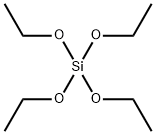에틸실리케이트 C화학적 특성, 용도, 생산
화학적 성질
Ethyl silicate is a flammable, colourless liquid with a mild, sweet, alcohol-like odour. Exposure to ethyl silicate can occur through inhalation, ingestion, and eye or skin contact. It is practically insoluble in water, soluble in alcohol, and slightly soluble in benzene.
용도
Tetraethyl Orthosilicate is used in the preparation of antidreflective coatings on silicate glass via silicon dioxide. Crosslinking reagent.
생산 방법
Prepared from absolute alcohol and silicon tetrachloride.
일반 설명
A clear colorless liquid with a faint odor. Flash point 125°F. Less dense than water. Vapors are heavier than air.
공기와 물의 반응
Flammable. Practically insoluble in water. Reacts slowly with water to form silica and ethyl alcohol [Merck].
반응 프로필
Tetraethyl orthosilicate reacts exothermically with acids Strong oxidizing acids may cause a reaction that is sufficiently exothermic to ignite the reaction products. May generate with caustic solutions. May generate flammable hydrogen with alkali metals and hydrides.
위험도
Moderate fire risk. Strong irritant to eyes,
nose, throat.
건강위험
Exposures to ethyl silicate cause adverse health effects. The symptoms of poisoning include, but are not limited to, irritation of the eye, mucous membrane, respiratory tract, respiratory difficulty, tremor, fatigue, narcosis, nausea, and vomiting. Prolonged periods of skin contact may produce drying, cracking, inflammation, and dermatitis. As observed in laboratory animals, occupational workers exposed to the chemical substance may suffer from liver and kidney damage, CNS depression, and anemia. At concentrations of 3000 ppm, ethyl silicate causes extreme and intolerable irritation of the eyes and mucous membranes; at 1200 ppm, it produces tearing of the eyes; at 700 ppm, it causes mild stinging of the eyes and nose; and at 250 ppm, it produces slight irritation of the eyes and nose.
화재위험
HIGHLY FLAMMABLE: Will be easily ignited by heat, sparks or flames. Vapors may form explosive mixtures with air. Vapors may travel to source of ignition and flash back. Most vapors are heavier than air. They will spread along ground and collect in low or confined areas (sewers, basements, tanks). Vapor explosion hazard indoors, outdoors or in sewers. Runoff to sewer may create fire or explosion hazard. Containers may explode when heated. Many liquids are lighter than water.
Safety Profile
Poison by intravenous
route. Moderately toxic by other routes. A
skin,mucous membrane, and severe eye
irritant. Narcotic in high concentrations.
Flammable liquid when exposed to heat or
flame; can react vigorously with oxidzing
materials. When heated to decomposition it
emits acrid smoke and fumes. See also
ESTERS.
잠재적 노출
Ethyl silicate is used as a binder in
production of cases and molds for investment casting of
metals. The next largest application is in corrosion-resistant
coatings; primarily as a binder for zinc dust paints.
Miscellaneous uses include the protection of white-light
bulbs; the preparation of soluble silicas; catalyst preparation and regeneration; and as a crosslinker and intermediate
in the production of silicones
운송 방법
UN1292 Tetraethyl acetate, Hazard Class: 3;
Labels: 3-Flammable liquid.
Purification Methods
Fractionate it through an 80cm Podbielniak type column (p 11) with a heated jacket and partial take-off head. It is slowly decomposed by H2O-and is soluble in EtOH. It is flammable-it irritates the eyes and mucous membranes. [Sumrell & Ham J Am Chem Soc 78 5573 1956, Bradley et al. J Chem Soc 5020 1952, Beilstein 1 IV 1360.]
비 호환성
May form explosive mixture with air.
Strong oxidizers; strong acids; water.
폐기물 처리
Incineration in admixture
with a more flammable solvent.
주의 사항
Occupational workers should avoid contact between ethyl silicate and strong oxidizers, water, mineral acids, and alkalis. Workers should use appropriate personal protective clothing and equipment that must be carefully selected, used, and maintained to be effective in preventing skin contact with ethyl silicate. The selection of the appropriate personal protective equipment (PPE) (e.g., gloves, sleeves, encapsulating suits) should be based on the extent of the worker’s potential exposure to ethyl silicate. There are no published reports on the resistance of various materials to permeation by ethyl silicate.
에틸실리케이트 준비 용품 및 원자재
원자재
준비 용품








